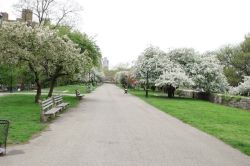Riverside Park
Invisible Man: A Memorial to Ralph Ellison
This monument along Riverside Drive at 150th Street honors writer Ralph Waldo Ellison (1914–1994), who is best known for writing the epic novel Invisible Man, the inspiration for the memorial. The 15-foot-high, 10-foot-wide bronze monolith – the center of which featuring a hollow silhouette of a man – was created by Elizabeth Catlett (1915-2012) and unveiled in 2003. The monument features two granite panels that are inscribed with Ellison quotes and a biographical panel. The Riverside Park Fund and Ralph Ellison Memorial Committee, a neighborhood group – some of whose members knew Ellison personally – helped build momentum for the project, raising private funds to commission and endow the sculpture in collaboration with a City-funded re-landscaping project.
Ralph Ellison was born in Oklahoma City in 1914. After attending Tuskegee Institute, he moved to New York in 1936 and worked on the Federal Writers' Project, part of the New Deal-era Works Progress Administration. His first novel Invisible Man (1952) – in which the African-American protagonist moves to New York, becomes caught up in the tumultuous civil rights issues of the time and ultimately recedes into “invisibility” – earned Ellison international fame and won him a National Book Award in 1953. Later in his life he taught at New York University. Ellison lived near this part of Riverside Park at 730 Riverside Drive, also known as the Beaumont, a distinguished residence that was also home to United States Senator Jacob Javits and singer Marian Anderson. Ellison died in 1994 and is buried at nearby Trinity Cemetery. His novel Juneteenth was published posthumously.
Sculptor Elizabeth Catlett was selected through an art competition held by the Riverside Park Fund and Ralph Ellison Memorial Committee. In her long career Catlett drew upon her experience as a black woman coming of age in an era of segregation. Working in many media, and especially accomplished in wood and stone carving, she drew on many influences from pre-Columbia art to contemporary sculpture and murals. An early work, Mother and Child (1939), won first prize at the American Negro Exposition in Chicago. While working at the George Washington Carver School adult education program in the 1940s Catlett met Ellison.
A social activist and critic of McCarthy-era repressive tactics, Catlett subsequently established residency in Mexico where she lived and worked for the remainder of her life. Catlett’s pieces can be seen in the permanent collections of the Metropolitan Museum of Art, the Museum of Modern Art, the Studio Museum of Harlem and the Cochran Gallery of Art in Washington, D.C. In 1998 she was the subject of a travelling retrospective, and shortly before her death inspired a major exhibition at the Bronx Museum of the Arts entitled Elizabeth Catlett in Conversation with 21 Contemporary Artists--a show that examined her lasting and far-reaching artistic influence.
Invisible Man is Catlett’s only public commission in New York. She chose as her central image a bronze in which a large striding and assertive figure is defined by its absence. This is in keeping with the themes of Ellison’s novel whose central protagonist wrestles with issues of racial identity, alienation and assimilation. A discrete yet embracing oval landscape was designed by Ken Smith to complement the sculpture, and provide a place of contemplation.
Check out your park's Vital Signs
Clean & Safe
Green & Resilient
Empowered & Engaged Users
Share your feedback or learn more about how this park is part of a
Vital Park System

Know Before You Go
Related inquiries may be sent to boatbasin@parks.nyc.gov
Related inquiries may be sent to boatbasin@parks.nyc.gov


